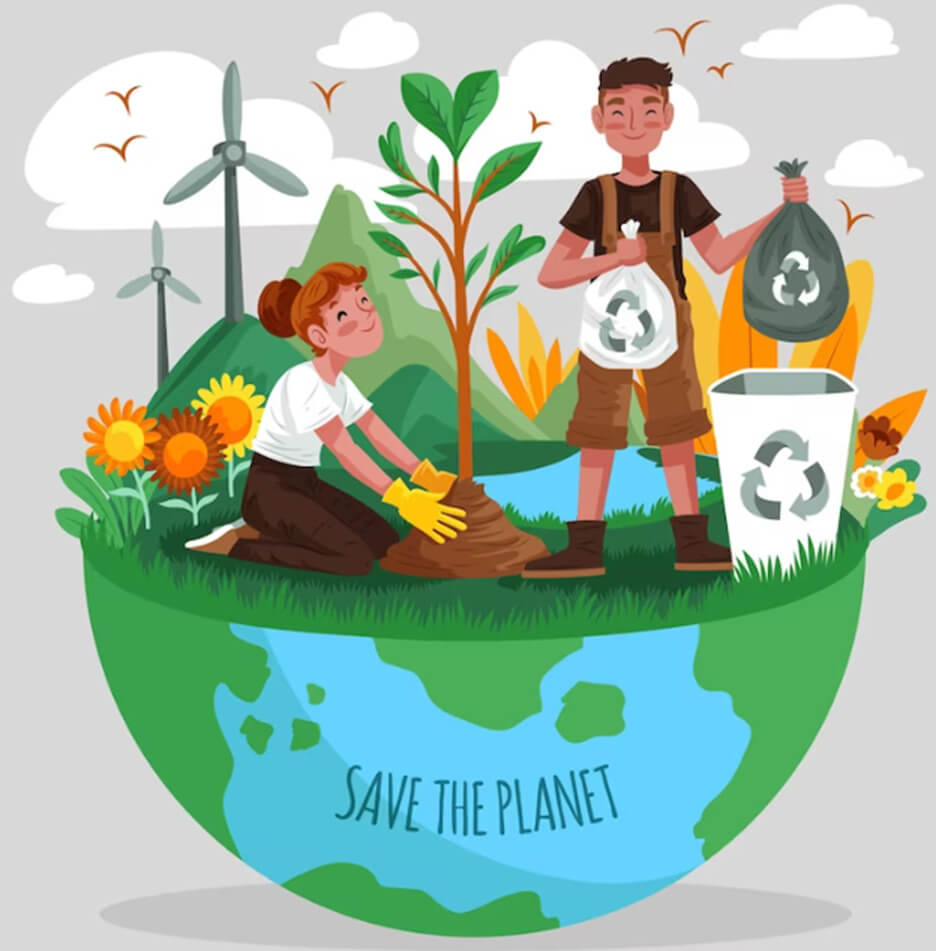Updated February 9, 2023
Essay on Save Environment
The environment plays a vital role in our lives, and we must do our part to keep it healthy and safe. Environmental problems are becoming more and more severe as time goes on, and we need to take action now to ensure that future generations can enjoy a healthy planet.
One of the most important things we can do to save the environment is to reduce our consumption. We should make conscious choices about the products and services we use and buy only what we need. We should also try to reuse and recycle items whenever possible, such as using durable and reusable containers instead of single-use items. We should also ensure to dispose of our waste and avoid littering properly. Let us find out more about the Save the Environment Essay.
(Image Credits: Freepik)
What is the Environment?
The environment is the natural world and all of the living things that inhabit it. Human activity impacts the environment, and it is essential to take steps to protect and preserve it.
What Forms the Environment?
The environment includes physical components such as air, land, water, and sunlight and biological components such as plants, animals, and microorganisms. Human activities, such as energy production, transportation, agriculture, and industry, also shape the environment.
How does this essay on Save Environment influence Life?
An environment can have a significant impact on the Life of an organism. It can provide resources that an organism needs to survive, such as food, water, and shelter. It can also provide environmental cues that prompt organisms to migrate, mate, or change their behavior. The quality of the environment and the availability of resources can determine how successful an organism is in its ability to reproduce and survive. Furthermore, environmental conditions can affect the genetic makeup of a species over time, either through natural or artificial selection.
Pollution effects
- Pollution has a devastating effect on wildlife and marine Life. Pollution can come in many forms, including chemical, physical, and biological contaminants. These pollutants can harm animals and their habitats in a variety of ways.
- Chemical contaminants can enter the environment through industrial waste, agricultural runoff, and oil spills. These pollutants can be toxic to animals, often leading to death or disease. For example, PCBs, DDT, and mercury can cause severe health problems in fish, birds, and mammals. Additionally, chemical contaminants can bioaccumulate in the food chain, leading to higher concentrations of toxic chemicals in top predators.
- Physical pollutants, such as plastic, can negatively impact wildlife and marine Life. Plastic pollution can entangle and choke animals, as well as block digestive tracts and cause starvation. Additionally, plastic can serve as a vector for chemical contamination, as chemicals can leach from the plastic, and animals consume it.
- Biological contaminants, such as bacteria and viruses, can also introduce into the environment through human activity. These contaminants can cause disease in wildlife and marine life, reducing populations.
- Pollution can have a devastating effect on wildlife and marine life, often leading to death or disease. It is essential to reduce pollution through responsible waste management, water conservation, and sustainable agricultural practices. Doing so can help protect and preserve wildlife and marine Life.
Initiatives to Save the Environment
#1 Plant Trees
Planting trees is one of the most effective ways to reduce the effects of climate change and help the environment. Trees absorb carbon dioxide, produce oxygen, and help reduce air pollution.
#2 Reduce, Reuse, Recycle
Reducing how much waste we produce, reusing materials, and recycling are all great ways to help the environment. They help reduce the amount of waste that goes into landfills, conserve natural resources, and reduce pollution.
#3 Use Renewable Energy Sources
Renewable energy sources like solar, wind, and geothermal can help reduce our dependence on fossil fuels like coal and oil. It can also help reduce the amount of pollution and greenhouse gas emissions.
#4 Support Sustainable Agriculture
Supporting sustainable agriculture can help reduce water pollution, conserve resources, and reduce the use of chemicals and pesticides.
#5 Conserve Water
Conserving water is a crucial way to help the environment. It can help reduce water pollution, conserve resources, and reduce the amount of energy used to process and transport water.
Environment-Friendly Strategies
#1 Reduce Waste
Implementing a waste reduction program is a great way to be more environmentally friendly. This could include strategies such as recycling, composting, and reducing packaging materials.
#2 Source Sustainable Products and Materials
Using sustainable materials and products in the workplace can help reduce environmental impacts. This could include sustainable sourcing furniture, office supplies, and other necessary materials.
#3 Utilize Renewable Energy Sources
Transitioning to renewable energy sources such as solar or wind power can help reduce the environmental impact of energy use.
#4 Encourage Sustainable Transportation
Offering incentives to employees who use public transportation, bike, or walk to work can help reduce air pollution.
#5 Improve Water Efficiency
Making small changes, such as installing low-flow fixtures and using native plants in landscaping, can help reduce water use and conserve resources.
#6 Promote Sustainable Practices
Educating employees on the importance of sustainable practices can help create a culture of environmental responsibility in the workplace.
Final Thoughts
We all must take an oath to protect our environment and respect its importance in our lives. We must work together to reduce our consumption, reuse and recycle products and materials, and use renewable energy sources. We must recognize the impacts of our actions and learn to adjust our lifestyles and habits to reduce our environmental footprints. We must also work to educate others and spread awareness about the importance of protecting our environment. Together, we can help to ensure that the environment is safe for future generations.

